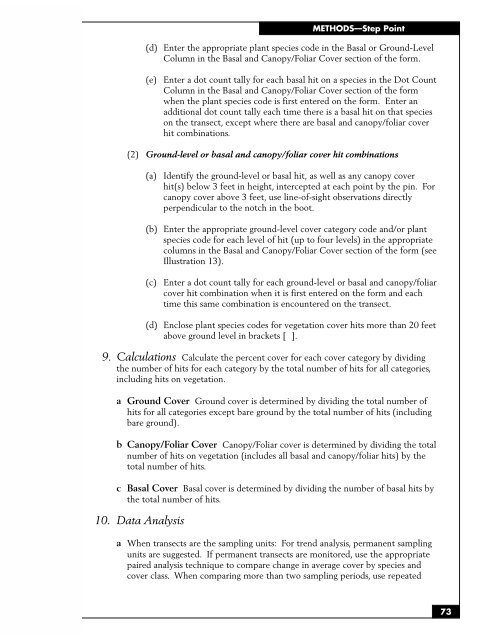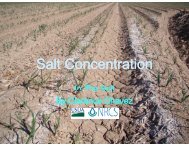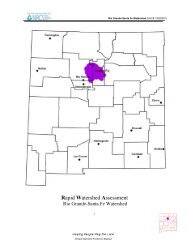SAMPLING VEGETATION ATTRIBUTES - New Mexico NRCS - US ...
SAMPLING VEGETATION ATTRIBUTES - New Mexico NRCS - US ...
SAMPLING VEGETATION ATTRIBUTES - New Mexico NRCS - US ...
Create successful ePaper yourself
Turn your PDF publications into a flip-book with our unique Google optimized e-Paper software.
METHODS—Step Point<br />
(d) Enter the appropriate plant species code in the Basal or Ground-Level<br />
Column in the Basal and Canopy/Foliar Cover section of the form.<br />
(e) Enter a dot count tally for each basal hit on a species in the Dot Count<br />
Column in the Basal and Canopy/Foliar Cover section of the form<br />
when the plant species code is first entered on the form. Enter an<br />
additional dot count tally each time there is a basal hit on that species<br />
on the transect, except where there are basal and canopy/foliar cover<br />
hit combinations.<br />
(2) Ground-level or basal and canopy/foliar cover hit combinations<br />
(a) Identify the ground-level or basal hit, as well as any canopy cover<br />
hit(s) below 3 feet in height, intercepted at each point by the pin. For<br />
canopy cover above 3 feet, use line-of-sight observations directly<br />
perpendicular to the notch in the boot.<br />
(b) Enter the appropriate ground-level cover category code and/or plant<br />
species code for each level of hit (up to four levels) in the appropriate<br />
columns in the Basal and Canopy/Foliar Cover section of the form (see<br />
Illustration 13).<br />
(c) Enter a dot count tally for each ground-level or basal and canopy/foliar<br />
cover hit combination when it is first entered on the form and each<br />
time this same combination is encountered on the transect.<br />
(d) Enclose plant species codes for vegetation cover hits more than 20 feet<br />
above ground level in brackets [ ].<br />
9. Calculations Calculate the percent cover for each cover category by dividing<br />
the number of hits for each category by the total number of hits for all categories,<br />
including hits on vegetation.<br />
a Ground Cover Ground cover is determined by dividing the total number of<br />
hits for all categories except bare ground by the total number of hits (including<br />
bare ground).<br />
b Canopy/Foliar Cover Canopy/Foliar cover is determined by dividing the total<br />
number of hits on vegetation (includes all basal and canopy/foliar hits) by the<br />
total number of hits.<br />
c Basal Cover Basal cover is determined by dividing the number of basal hits by<br />
the total number of hits.<br />
10. Data Analysis<br />
a When transects are the sampling units: For trend analysis, permanent sampling<br />
units are suggested. If permanent transects are monitored, use the appropriate<br />
paired analysis technique to compare change in average cover by species and<br />
cover class. When comparing more than two sampling periods, use repeated<br />
73




